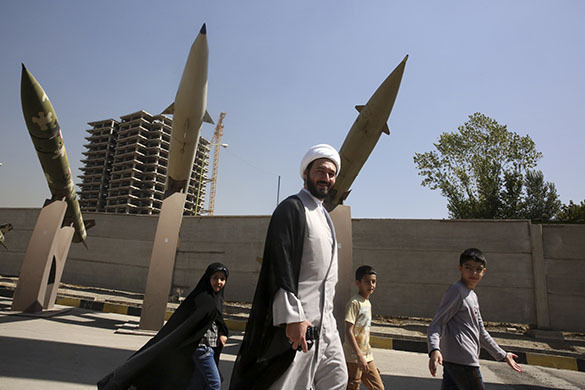USA wants to settle scores with Iran, rather than its nuclear program
The talks on the Iranian nuclear program are doomed to fail because the United States wants to settle scores with Iran in the first place, rather than with its nuclear program. Obama himself does not believe in the success of the talks. Yet, there are many questions to ask the United States, rather than Iran. Who was helping Pakistan to build nuclear weapons? Where did Israel get its nuclear bombs from? Why is the USA modernizing its nuclear arsenals?

Iran's uranium enrichment centrifuges will not be either dismantled or destroyed. The country will be able to continue the construction of a heavy water nuclear reactor in Arak and retain scientific nuclear capabilities. Iran promised in response to grant access to IAEA experts to its nuclear facilities. The experts will need to evaluate the level of uranium and plutonium enrichment that should not exceed 20 percent.
Officially, about 95 percent of the document has been coordinated. The main point of the talks is disagreement on the subject of lifting of sanctions. Iran wants all sanctions to be lifted immediately. while the West insists on phasing the sanctions out, depending on how Iran implements the agreements.
The question of the lifting of sanctions is highly important, of course. IAEA inspections are likely to be politically motivated, while the international community has no reason to question Iran's peaceful intentions: to produce a nuclear bomb, uranium must be enriched on the level of 90 percent.
For the US, it is vital not to hurt American transnational companies that are already prepared to rush to the Iranian oil and gas market. In addition, oil and gas from Iran may cut the price on hydrocarbons that may strike another serious blow on the Russian economy. To crown it all, US President Obama hopes that the agreement with Iran will help him justify his Nobel Peace Prize title.
Obama's initial requirements were much tougher: the US originally insisted all nuclear reactors in Iran should be closed. However, Russia and China did not support the United States and "returned" centrifuges and scientific institutions to Iran. Iran can be trusted: the country has never invaded another state, while the United States has experience in using nuclear bombs and can hardly be called a role model in terms of nuclear non-proliferation.
It was USA that started Iranian nuclear program
Paradoxically, it was the United States that initiated the Iranian nuclear program. On December 8, 1953, US President Dwight Eisenhower proposed at the UN General Assembly all developing countries to develop peaceful nuclear energy.
Eisenhower said that the USA would be ready to help all countries in need by sharing technology and expertise in the field of nuclear industry. In 1957, Tehran and Washington signed a nuclear cooperation agreement. In 1967, the United States built the first nuclear reactor in the Iranian capital, and Iran started receiving enriched uranium.
In July 1968, Iran signed the Treaty on the Non-Proliferation of Nuclear Weapons (NPT) and ratified it in 1970. The Islamic revolution of 1979 undermined the credibility of the United States to Iran.
The United States is not traveling on the road of nuclear disarmament. Even before the events in Ukrainian and Russia's plans to modernize its nuclear intercontinental ballistic missiles in 2013, the US Congress approved a ten-year program to improve its nuclear arsenal by 335 billion dollars. In January 2015, this program was increased to 348 billion, according to the report from the Congressional Budget Office (CBO).
On average, it goes about $35 billion per year (for comparison, Russia's military budget for 2015, according to SIPRI, makes up 84,5 billion dollars). This is only five percent of the total amount of expenditures on national defense. Just think about it. The money will be spent on costs associated with strategic and tactical forms of nuclear weapons their delivery systems, etc.
Last week, it was reported that the USA successfully tested a new modification of the B61-12 bomb. The explosive power of the bomb has been increased by one-third and amounts to 30 kilotons.
In addition, the US had resumed the production of weapons-grade plutonium and opened a nuclear factory in Kansas. To crown it all, representatives of the Obama administration stated that the USA was considering an opportunity to deploy nuclear missiles in Europe. This is only the part of news that receives public exposure and coverage. One shall assume that there is a lot more happening that we do not know.
"Russia is strongly against the proliferation of nuclear weapons in the world. Yet, there are many questions as to who was helping Pakistan in building its nuclear bombs and how Israel de facto obtained nuclear weapons. Our partners in the West appear do not want these questions to be answered," Adzhar Kurtov, historian, political scientist, editor in chief of Problems of National Strategy journal told Pravda.Ru.
Modernization of nuclear potential is a very dangerous game ере can trigger an armed conflict in Eastern Europe, for example. "I think there is this is a game of traditional bullying. In the United States, there are forces that believe that they can do what they once did to the Soviet Union, when they had the USSR involved in an arms race to weaken its economy. Yet, I do not think that the Russian administration wants to get involved into another arms race with the West," the expert told Pravda.Ru.
Lyuba Lulko
Pravda.Ru
Read article on the Russian version of Pravda.Ru
Also read:
Secrets of Iranian nuclear program
USA weaves nuclear fairy tale on Iran
Subscribe to Pravda.Ru Telegram channel, Facebook, RSS!


